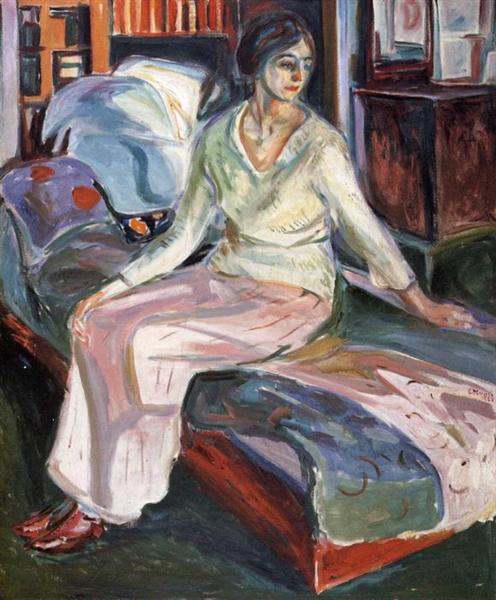Description
The painting "Model on the couch" (1928) by Edvard Munch is in a marked artistic context that reflects both the evolution of Munch himself and the currents of expressionism that dominated the twentieth century. The work is a testimony of its continuous search to capture the complexity of human emotions and the link between the artist and the model. It shows a female figure reclined on a sofa, who radiates a mixture of serenity and melancholy. This subtle balance is characteristic of Munch's work, where the visible and the emotional usually intertwine.
The composition of the work stands out for its approach to the central figure, which prevails over an ethéreo and almost abstract fund. Munch uses a use of curved lines and a soft treatment of the form that gives the figure an atmosphere of fragility. This curvature not only suggests the body of the reclining model, but also establishes a fluidity that invites the viewer to focus on the emotions that emanate from the image. The couch, as a structural element in painting, works not only as a furniture, but as a kind of emotional landscape, a space that encapsulates the mental state of the figure.
The use of color is equally significant. Munch opts for a palette that oscillates between green, blue and warm skin tone of the figure, creating a contrast that highlights the humanity of the model against a more diffuse and gloomy background. This color use can be interpreted as a reflection of internal emotions; Blue and green, with their connotations of sadness and yearning, are combined to manifest a sense of introspection, while the warmer tone of the skin offers a tangible connection with human reality.
While the figure on the couch is the focus of attention, the symbolism that the environment establishes should not be ignored. The space seems to wrap the model, suggesting both protection and isolation. This duality has been a recurring theme in Munch's work, where the tensions between the desire for connection and the experience of loneliness are often explored. This resonates especially in his work, where the figure feels both linked to the place where he is trapped in his own emotions.
Edvard Munch, known for his explorations on anguish, loneliness and sensuality, continues to challenge and fascinate contemporary audiences through works such as "Model on the couch." Painting is a clear example of the development of its style, which fuses elements of symbolism and expressionism. Munch could have felt attracted to surrealism that would arise in later decades, although its previous production already contained the nuances of subjectivity that surrealism would explore later.
Throughout his career, Munch has maintained a personal voice, which goes beyond the artistic movements in which he was immersed, becoming a bridge between figurative painting and future trends of modern art. Munch's ability to communicate the depths of the human soul on a canvas remains relevant, and "model on the couch" is a piece that perfectly encapsulates that mission. In this way, the viewer not only faces a visual representation, but to a continuous dialogue between the artist and art, where intimacy and vulnerability are revealed in each line.
KUADROS ©, a famous paint on your wall.
Hand-made oil painting reproductions, with the quality of professional artists and the distinctive seal of KUADROS ©.
Art reproduction service with satisfaction guarantee. If you are not completely satisfied with the replica of your painting, we refund your money 100%.

